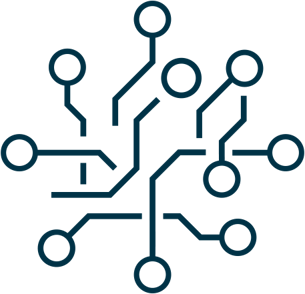Developments in the field of artificial intelligence (AI) are progressing rapidly. It's difficult to keep track of everything. It is even more challenging to recognize the concrete benefits of AI for your own company. Digital assistants are a proven use case. For example, they answer questions from employees or customers. A large Swiss health insurer has introduced such a solution in customer service for its agents. The result: a better customer experience and significantly shorter processing times.
Anyone who also wants to introduce an AI solution is faced with important questions: Is a standard solution enough? Or is a customized solution the better option? And if the latter, should it be developed internally or with an external partner?
We show how an individual solution can be successfully implemented and deliver concrete results.
Getting started with a plan
AI is widely and intensively discussed. Many companies therefore want to get started quickly. However, a hasty start can backfire later: with a fragmented system landscape, redundancies, and high costs. Sometimes there is even the threat of a cloud project being canceled or postponed. Especially the choice of cloud technology can only be corrected later with great effort, as all major providers offer similar but not identical environments and services. Therefore, it is worthwhile to determine and evaluate the right architecture and the technology stack to be built on from the beginning.
Before specific AI projects are launched, it should be clarified whether a cloud strategy already exists. If so, it should be built upon. If not, this does not mean that you have to wait. Gaining experience with a proof of concept is an important step. Therefore, initial cloud or AI projects can start, but they should not be in business-critical areas. A good example is an internal digital assistant that answers questions. This way, you can gain initial experience while developing the cloud strategy in parallel.
Choosing the right cloud deployment option
A key question of the cloud strategy is: Which cloud options and services suit us? And how do we combine public cloud, private cloud, and local systems (on-premises) into a hybrid system landscape if needed? The decisive factors are security requirements and the need for control over the system, data, and, when using generative AI, the Large Language Models (LLM).
All cloud options can generally be extended with various LLMs. In the public or private cloud, providers directly offer these models. With an on-premises solution, an open-weight model like Meta’s Llama or Mistral is usually used. These models can be downloaded, fine-tuned, and executed in your own infrastructure.
For the mentioned digital assistant that answers internal questions, an on-premises or private cloud approach can be the best choice, especially when dealing with particularly sensitive data.
Agility, data control, IP ownership
Markets and customer needs are constantly changing. That's why companies need to be flexible and able to act quickly. Those who want to stand out from the competition need more than a standard solution. Using the same tools as everyone else may not be the best match due to a lack differentiation.
A customized cloud solution offers advantages here. It ensures that high enterprise requirements for security and compliance are met. It also allows the solution to adapt to the company – not the other way around. The cloud solution can also be modularly expanded and flexibly scaled. Those who choose this path design their own roadmap and reduce dependence on SaaS providers who also serve competitors.
Another advantage of an individually developed solution in a private cloud is the increased control over your own data. Depending on the chosen cloud variant, this data is not shared with third parties. With an on-premises solution, it even remains entirely within the controllable infrastructure.
Integration benefits
Companies usually already rely on various systems, providers, and solutions. Therefore, it is crucial that new applications can be seamlessly integrated into the existing environment. SaaS solutions often reach their limits here. A custom-developed solution can usually be integrated much better – provided the appropriate interfaces are available.
A cloud solution helps to better utilize existing resources. This applies not only to technical but also to personnel and administrative resources. If a company already uses a cloud platform, no new contracts with new suppliers are needed. This saves time, as the review and approval of new providers can take several months in an enterprise environment. Internal teams already familiar with the chosen cloud environment are able to develop their own solutions, significantly reducing time-to-market. And with the support of an external implementation partner, these teams can later take over operations and further development, preferably using a DevOps approach.
When looking at the investment required, the initial costs of in-house development stand out. These can be around 20 to 40 percent higher in the first year than with a standard solution. However, in the long term, the picture looks different: The total cost of ownership (TCO) is often lower, as there are no ongoing SaaS fees. Instead, only the cloud resources actually used are charged.
The arguments for standard solutions
In a competitive environment, it is crucial to be quick to market. A SaaS solution is often ready to use immediately, giving it a time advantage over a custom solution that first needs to be developed. However, this advantage can be lost if a lenghty procurement process for a new supplier relationship or major adjustments to interfaces and workflows are necessary.
While a SaaS solution incorporates the experience of other clients and best practices, a custom solution may not be able to match this breadth of experience. An experienced implementation partner can help by bringing in this perspective and experiences from other client projects.
Users without a technical background can usually achieve a goal with a SaaS solution without prior knowledge and with little effort. With a custom solution, there is still a need to rely on IT or an external service provider for adjustments. In practice, however, every SaaS also needs its internal experts. This knowledge must also be built up first, which can create internal bottlenecks if these experts are overloaded.
Balancing standardization and customization
The pace of AI development remains high. Keeping pace or staying ahead of competitors will be a key competency for companies. To avoid rushing into the adventure without a plan, a long-term and well-thought-out cloud and AI strategy is needed. This includes the balance between proven standardization with SaaS solutions and customization with tailor-made AI solutions, whether in a public cloud, private cloud or on-premises if required.
This article (German) was initially published in Netzwoche on June 30, 2025
Written by

Patrik Meier
Head of Cloud Solutions

Pascal Rosenberger
Senior AI Consultant



